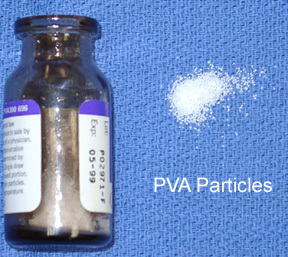The UFE procedure
Through a tiny skin nick at the groin we access the femoral artery with a small tube (catheter) that we manipulate into the arteries feeding the uterus.
We perform an arteriogram, a roadmap of the arteries, by injecting an iodine-containing fluid while taking several digital x-rays. Here is an example of a digital arteriogram of the left uterine artery; the arteries are dark.
To see the blood vessels better, we subtract out the bones and background from the picture. This is called a "digital subtraction arteriogram" or DSA.
To better understand the relationship of this artery to the uterus, fibroids, and left ovary, I will superimpose this arteriogram on the MRI
Then we inject a slurry of tiny particles that are carried downstream in the arteries to the uterus and fibroids. We usually use FDA-approved Embospheres for UFE, though on occasion we will use other materials, such as polyvinyl alcohol (PVA), with proven embolic track record
Blood flow to the fibroids is so much higher than the uterus that the vast majority of the particles are carried to the fibroids. These particles then block flow through the arteries. The tiny arteries into the muscle of the uterus are too small to get clogged with the arteries. And these arteries begin to dilate after a short while in response to the decreased blood flow. The arteries to the fibroids cannot dilate. And that is why the fibroids die while the uterus survives. The image below shows how flow has decreased in the artery after UFE
That is it for the left side. Next I perform the nerve block and then repeat the above steps for the right side. Once the flow is adequately slow, the catheter is removed as we deploy a device that helps the artery heal quickly. We apply pressure by hand to the puncture site for a few minutes. Then we cover it with a band-aid: no stitches, no staples.







